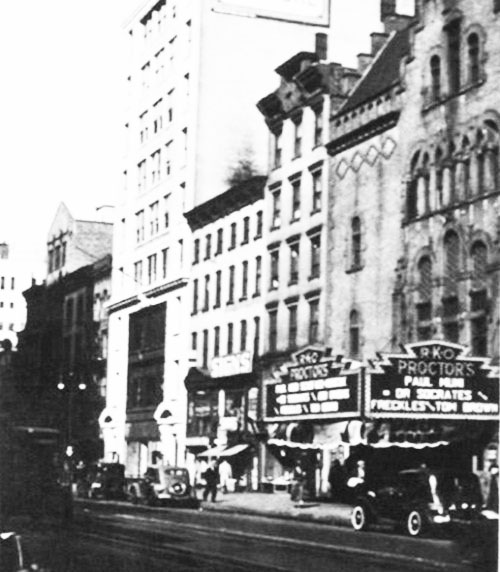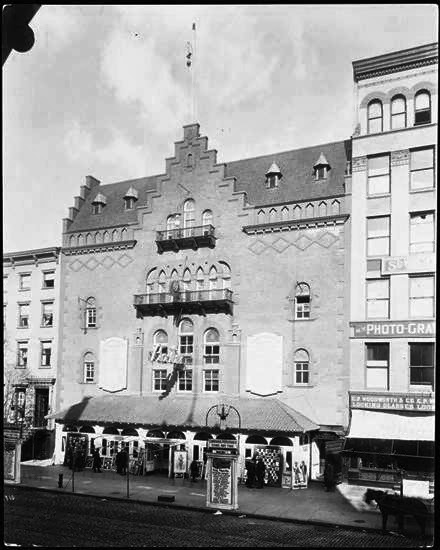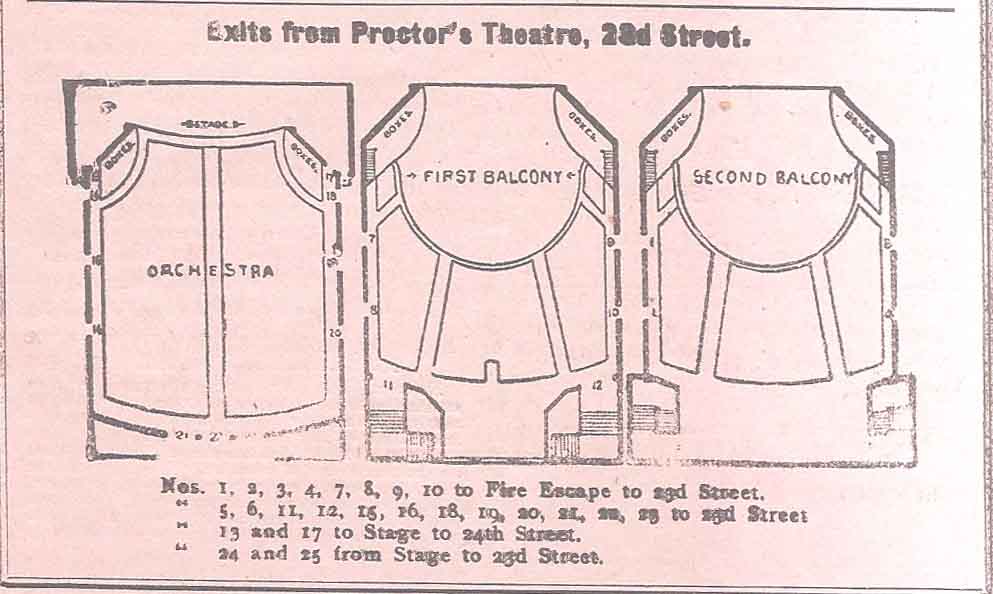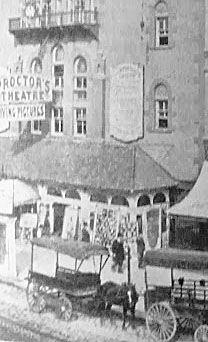Proctor's Theatre
139 W. 23rd Street, New York, NY 10011
1100 seats / opened 1889 - demolished 1937


Its opening delayed by the discovery during excavation of flowing springs with water of such “remarkable purity”
(according to The New York Times) that it would be used both to fill the rooftop water tanks and for drinking purposes.
Proctor and Turner’s Twenty-Third Street Theatre presented the stage production “A County Fair” on March 6, 1889.
Frederick Francis Proctor’s intention, upon entering the New York City market, was to present legitimate theatre at
prevailing Broadway prices. For this venture, his theatre design included electric lighting throughout
(with gas fixtures installed in case of equipment failure),
a gray-blue ceiling supported by walls of reddish gold, rails and a proscenium arch of gilded gold, and draperies of stamped velvet.
Within a few short years, Proctor was exclusively presenting vaudeville at this 1,500-seat venue and the later additions to his NYC empire.
By 1896, this theatre was presenting projected moving pictures via Edison’s Vitascope. In the early-1900’s it was operated as the
Keith & Proctor’s Twenty-Third Street Theatre until the partnership was dissolved in 1911. It continued to feature motion pictures,
as part of a vaudeville program in the first decades of the 20th century, until March 7, 1937, when the damage caused by a fire forced its closure.

In 1883 Manhattan’s entertainment district ran along West 23rd Street. The thoroughfare was dotted with music halls and theaters between Fifth and Eighth Avenues.
Some were quite grand like the white marble Grand Opera House on the northwest corner of Eighth Avenue and Booth’s Shakespearean Theatre at the southeast corner of
Sixth Avenue; others were noisier and robust like Koster & Bial’s Music Hall. But when Salmi Morse tried to get into the act, he was met with stern opposition.
Morse purchased “the Armory,” an old structure previous used a “Dr. Sause’s church, on the north side of 23rd Street, between Sixth and Seventh Avenues,
and set to work converting it to a theater. His intention —a quite lofty one in his mind— was to stage a Passion Play here.
As rehearsals and $70,000 renovations continued, he applied for a license for run his theater.
Mayor William Russell Grace was the founder of W. R. Grace & Company and the city’s first Roman Catholic mayor. He denied Morse’s application because,
according to The New York Times, he “thought the play sacrilegious.” Witnesses at a subsequent hearing were confused—testifying that rehearsals proved that
the play was simply a reenactment of the life of Christ. (It is quite possible that the religious mayor was offended by a church building being used as a place
of entertainment; or possibly it had something to do with Salmi Morse’s real name being Solomon Moses.)
When Grace’s term ran out Morse reapplied to the new mayor, Franklin Edson, who also denied the license on the grounds that the play was sacrilegious.
The producer pressed on, continuing rehearsals in February 1883 in his Temple Theatre. When police arrived to make sure he was not operating without a license,
an offended Morse replied “My object is too dignified for me to try to bring out the Passion surreptitiously or to evade the law.”
Morse tried another tactic. He planned a full dress rehearsal and issued invitations to prominent citizens. The publicity of the several hearings regarding the
supposedly irreverent play worked to Morse’s advantage. According to newspapers, no fewer than 2,000 people crowded into the Temple Theatre.
“Gentlemen whose clothes and air were clerical mingled in the throng; the Hebraic element was noticeable, and there were many actors and actresses whose successes,
such as they were, were made years and years ago. Sealskins and diamonds were as plentiful as at a Wallack or Union-Square matinee, and everybody seemed to expect an
evening of uninterrupted pleasure,” reported The New York Times. An uninterrupted evening was not to be. The audience was thoroughly enjoying the lavish production when
suddenly the producer’s attorney stepped in front of the footlights. “He emphatically expressed his regret that in the midst of beautiful concerted sacred music Mr. Morse
had been arrested by the Police. A storm of hisses filled the house, and cries of ‘Shame! Shame!‘ were heard in the balcony and orchestra.”
Ironically, Morse received his license within a few months—public outcry no doubt having much to do with the decision —
but then died under suspicious circumstances a year later. Suicide was suspected.
The Temple Theatre was purchased by the Gospel Tabernacle and reopened as the Twenty-third-Street Tabernacle. While it was supposedly a house of worship, the first thing the
Tabernacle did was stage “Othello.” On April 10, 1884 The Times reviewed the play, approving black actors on stage rather than whites in black face. Heretofore there
“were the minstrels and the ham-fat men, to be sure, but no self-respecting colored man would give countenance to such low-down imitations of white trash foolishness.
It has long been felt that no person in the upper circles of colored society could as much as think of a race theatre until one of Shakespeare’s
best tragedies had been placed upon the boards by colored actors and actresses of undoubted ability.”
The Tabernacle Theatre did not survive and on June 21, 1888 The Times reported that “The walls of the old church in Twenty-third-street just west of Sixth-avenue, which afterward
became Salmi Morse’s theatre when the unfortunate manager undertook to produce the Passion Play, have been leveled to the ground, and work on the new theatre which is to rise on
the site is being rapidly pushed.”
Impresario Frederick Francis Proctor built an impressive structure in the latest architectural rage — Flemish Revival. The brick-clad theater, which quaintly recalled Manhattan’s
Dutch heritage, featured a central and flanking stepped gables, picturesque capped dormers and a wide exterior balcony. Large brass letters were embedded into the sidewalk
spelling out PROCTOR’S.
Inside patrons were dazzled by electric lighting (although, as was customary, gas fixtures were available should the often-unreliable electricity fail). The 1,550-seat auditorium
featured gilded railings, velvet draperies and a gray-blue ceiling above red-toned walls.
While Proctor, at least initially, offered legitimate theater; he sought out innovative means to lure audiences. On December 2, 1890 The Times wrote a critique of the afternoon performance
the day before—during which bird-imitator Mable Stephenson shared the program with a one-act play “Barbara” and an exhibition of the new-fangled phonograph.
The newspaper (while noting the “not very numerous audience”) thought Mable “a remarkable mimic;” panned “Barbara” as “an early work and bears the impress of juvenility, and is
based on a mock sentimental idea such as might occur to a very young person who had read too many books of fiction and not seen much of the world;” and had mixed thoughts about the phonograph.
“The exhibition was startling, but not pleasing. The phonograph emphasizes defects and blemishes as the camera used to before photographers became artists. A cornet is distressing
enough at any time. When its notes are treasured up on the phonograph cylinder and ground out by electricity the result is almost maddening.”
That same year David Belasco and Henry DeMille produced Men and Women here, a drama that dealt with the political and business life in America. Later DeMille staged his last play,
The Lost Paradise, at Proctor’s before his sudden death.
In 1892 Proctor switched from legitimate plays to vaudeville, becoming the first such venue in New York. He offered continuous performances from noon to midnight six days a week.
For the price of admission a patron could stay all day and New Yorkers became familiar with his marketing slogan “After Breakfast Go to Proctor’s, After Proctor’s Go to Bed.”
In November that year Annie Eva Fay took the stage to conduct a séance before an audience of 1,500. Although Fay was internationally famous as a medium and mentalist, The Times was
not impressed. “There was nothing in
of tambourines, banjos, guitars, and bells played the principal roles.” The newspaper, as it would turn out years later, was correct. Annie Fay was later exposed as a fraud.
Proctor managed to draw a wide variety of talent to the Twenty-third Street Theatre. During the 1890s Ruth St. Denis landed an engagement here, dancing twice a day. Her artistic
talent, however, was in stark contrast to the sometimes-plebian vaudeville acts. When the wealthy Mrs. Orlando Rouland saw St. Denis’s “hindoo” dance drama one afternoon, she was
taken with the dancer; but appalled at the monkey act that followed. She offered to sponsor St. Denis in a “proper uptown theatre;” the dancer’s first real break.
A newspaper at the time complained about the theater’s admission prices. “At Proctor’s one has to pay fifteen cents to roost ‘among the gods,’ and the prices range as high as $1 for
‘a seat in a box.’” But Proctor countered explaining it was “a first-class place of amusement at reasonable prices, that will combine the comforts and privileges of a ladies’ club with
the entertainment of a select and carefully-managed theatre, where comic opera, the cream of the vaudeville stage, with musical sketches and crisp, bright comedy will be presented.”
Proctor was proud of his innovative “ladies’ club.” Women of the 1890s were necessarily careful about their reputations and the theater was a perfect place to lose them.
On January 10, 1893 the Times noted that “The ‘ladies’ club’ idea is one that the management wants particularly to emphasize. According to the announcement
‘features include cozy parlors, dressing and toilet rooms, decorated and furnished artistically and luxuriously, where ladies may enjoy the same degree of privacy and comfort
that they would if at home.’ This ‘ladies’ club’ idea is rather indistinct at present, but may develop. The management reserves the right to exclude objectionable characters.”


Programs available from this theatre:
Vaudeville Program / Hathaways Theatre / 1906
Return to Index of Theatres
![]()



